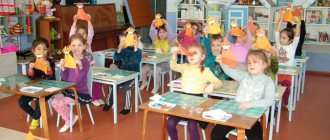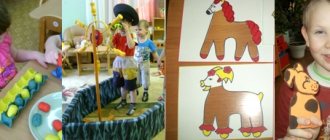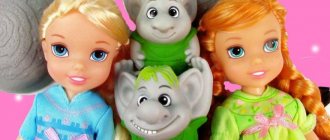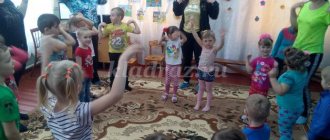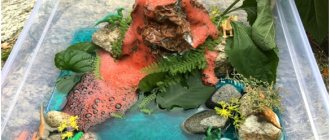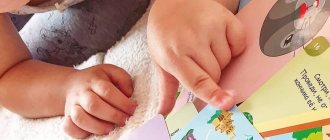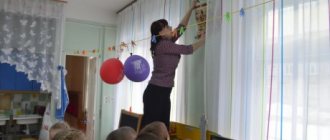Educational games in kindergarten are an integral part of the educational process. A kindergarten or preschool educational institution (preschool) is a type of educational institution whose main purpose is to implement a preschool education program. This is an affordable solution to the problem of parental employment. All preschool institutions provide care, education, development, supervision, and health improvement for children. A game is a special form of learning about the world, allowing a child to learn about the world around him in a simplified form and gain new experiences necessary for later life. What is the role of educational games in DOW? What is the difference between educational games in the younger group and the preparatory group?
Educational games in kindergarten: functions of games in the educational process
Attending kindergarten is an important stage in the life of any child. It is in the process of kindergarten education that the child gains his first experience of communicating with elders and peers, learns new models of behavior, and gets used to organizing the day. One of the main functions of any preschool institution is the education and development of the child. Every child learns about the world around him through games and toys.
A game is a form of activity and interaction between participants in the process, the main motive of which is to model a certain situation in a simplified form and test it in practice. Play for a child begins at an early age with learning about the world around him by studying surrounding objects and comparing them. The main elements of play for a child are both toys and objects from the surrounding world. The first year of a child’s life is characterized by the most intensive development and acquisition of basic skills, which will only improve in the future. With the acquisition of new skills and experience, the games that interest the child become more complex. Educational games in kindergarten contribute to the development of perception, logical, creative thinking, memory, attention, and imagination. Another important characteristic of educational games in dow is the socialization of the child, his involvement in team play, learning to evaluate and distribute roles.
Unlike the educational games that children enjoy at home, educational games in kindergarten are completely controlled by the teacher. Depending on the type of preschool institution, educational games in a preschool can be aimed at correcting certain conditions (physical development, mental development, speech therapy defects) and developing creativity.
Educational games in kindergarten are offered to children taking into account the age, level of development, abilities, and capabilities of the children. It should be noted that games in the younger group differ significantly from the games offered to children in older groups of kindergartens. What are these differences?
Games and toys for kids
Contained in sections:
- Didactic games 32256
- Sensory development and education. Sensory 6574
Includes sections:
- Didactic and sensory aprons and skirts 100
- Smell. Games, manuals “Recognize by smell” 9
- Velcro games 102
- Keyboard games 12
- Games with rubber bands 63
- Flashlight games 33
- Palms. Games, teaching aids 50
- Marbles. Games with pebbles 193
- Couple, pick a couple, couple pictures 281
- Pick up a patch. Games, teaching aids 65
- Clothespins. Games with clothespins for children 488
- Tactile development of children. Games and benefits 437
- Color, learning colors. Games, teaching aids 1507
- Laces. DIY games with laces 167
- Noise boxes. Games, educational aids 25
By groups:
- Junior group
Showing publications 1-10 of 1212. All sections | Sensory games
New
Photo
The best
The meanings of didactic games in the sensory education of children The meanings of didactic games in the sensory education of children Galina Aleksandrovna Maltseva Educator, MBDOU “Kindergarten of general developmental type No. 68”
G. Chita, Trans-Baikal Territory Abstract: the article discusses issues of interaction between teacher and family, as well as
sensory development...
Card index of didactic games for the sensory development of young children Card index of didactic games aimed at the sensory development of young children. Didactic games for learning colors : Game “Find the extra ball”
Goal: to consolidate knowledge of colors.
Materials: plastic balls, 4 of each color (yellow, red, blue, yellow)
Procedure: place on…
Features of educational games in the younger group
Game is a unique mechanism that allows you to develop various qualities in a child. Thus, educational games in the younger group allow you to develop the child’s psyche, attention, fine motor skills, and logical thinking. Educational games for the youngest children have as their main goal the overall development of the child and his preparation for the next stage of development - preschool age.
In early preschool age, it is important to teach a child abstract thinking, logical analysis, planning and forecasting, and correct perception of the surrounding reality. Developmental games for preschool children are based on careful study and characterization of objects. Children are offered puzzles, mosaics, and various geometric shapes that develop the child’s spatial orientation. As a rule, in a preschool institution, games are played in groups, when children work together to solve assigned problems. Doing tasks in a group allows the child to learn how to work in a team, learn to coordinate their actions with the actions of other children, thereby learning the basics of relationships.
Educational games in kindergarten in the younger group are selected taking into account the developmental characteristics of children 3-5 years old. At this age, children are characterized by a certain independence and intolerance to adult help during games. The child strives to complete the task independently. As a rule, being under the care of parents, the child does not receive the same freedom of action as in kindergarten, where the child, being in a group of peers, cannot receive full attention from the teacher. The main task of the teacher is to monitor the child’s actions, analyze his abilities, acquired skills and abilities, as well as correct the educational process so that each child in the group receives comprehensive development.
Special attention in teaching and raising children in kindergartens is paid to physical development. Educational games in kindergarten are organized so that the child moves during the game and receives a certain physical activity. One of the exciting activities for children in the younger group is playing with suspended multi-colored paper butterflies, which will only be able to “fly” when the children blow on them with all their might. In this simple and uncomplicated game, the child develops coordination and lungs. The game can be modified and supplemented with the task of making the butterflies fly in a certain sequence: first red, then yellow, then blue.
MEMORY IS NOT ONLY VISUAL
A person remembers not only what he sees, but also what he hears or does. Little Man is no exception. Therefore, memory development must be comprehensive and affect all these aspects.
- Visual memory is developed by games for memorizing a drawing or picture with their subsequent description, describing from memory the location of objects in a room, on a shelf, on a table. You can ask the child to remember what he wore for a walk yesterday, what his mother was wearing. Or draw a grid of several cells on paper, place small objects in each, and then, after giving the child time to memorize, turn it away and swap several objects. Let him try to restore the original arrangement.
- Auditory memory is trained by memorizing poems, nursery rhymes, songs, as well as retelling fairy tales or impressions of significant events, and following oral instructions from an adult. For example, buy several items in an impromptu store and not forget anything. Or place items, setting the table, in a certain sequence.
- Motor memory can be trained by all kinds of games in which children repeat the movements of adults in a certain order. Sometimes an adult can “make a mistake,” while the child needs to do everything correctly and not get lost.
Advice
When going to the store or for a walk, plan your route in advance and ask your child to comment on where to go next. This is also auditory memory training.
Features of educational games in the preparatory group
Educational games for older preschoolers are also based on the characteristics of the age development of children. At this age, intensive physical development begins: nervous, endocrine, cardiovascular systems, musculoskeletal system. At the same time, the child’s psyche is reshaped, new psychological mechanisms and behavior are formed. At the age of 5-7 years, the formation of basic personal qualities occurs: personal motivation, new social needs arise (the need for recognition, approval, leadership).
The main task of educational games in the preparatory group is personal development, assistance in adaptation in the society of their peers, as well as preparing children for the next stage in development - school life.
To enter school, a child must have reading, writing, and counting skills. Developmental games in the preparatory group are aimed at developing these abilities. During this period, games take on a slightly different character: the gameplay increasingly imitates school activities.
During this period, children's knowledge and their analytical abilities are tested. Educational games in kindergarten allow you to consolidate acquired knowledge and skills about the main aspects of life and the world around us. Such skills and knowledge include the ability to distinguish good from bad by analyzing the proposed situation, distinguishing between domestic and wild animals, determining the seasons and relevant events, etc.
Games in kindergarten are an important stage in a child’s development, allowing them to understand the world around them in a simplified form and prepare for adulthood.
ATTENTION – ATTENTION
In order for a child to grow up attentive, be able to concentrate and quickly respond to any changes, it is important to train his attention. You can start as early as 4 years of age. At the same time, it is also not necessary to purchase expensive manuals: the suitable “equipment” is always at hand.
For example, you can play these games.
- Variations on the theme “edible - inedible” (sweet - unsweetened, flies - does not fly, clothes - not clothes).
- "What's new?" (on the table, in the picture, in the guise of dad, in mom’s clothes).
- “Find the differences” (in two pictures).
- “Caravan” - the mother names the animal, the child repeats it and adds his own. Mom repeats both and adds a third. You need to repeat in the order in which the animals are named. They play until someone gets lost.
- "What changed?". During a morning walk, mother and child try to remember everything that surrounds them, and in the evening they compare what has changed (someone hung up the laundry, old women sat on a bench, a car drove up to the next door);
- Close your eyes and name as many different sounds as possible in the room (a clock, the noise of a refrigerator, the purring of a cat) or outside the window (cars driving, birds singing, the wind rustling).
- Close your eyes and tell what order is on the shelf, on the table, what mom is wearing.
It is important to start with easier tasks, gradually making them more difficult, and not forgetting to praise your child for success.
Didactic games
The games below will not only encourage the timid and cheer up the crying one, but will also calm the overly naughty child, redirect attention and help relax the angry, aggressive child.
Playing with a dog
Material. Toy dog.
Progress of the game. The teacher holds the dog in his hands and says:
Bow-wow! Who's there? This is a dog visiting us. I put the dog on the floor. Give Petya a paw, little dog! Then he approaches the child, whose name is named, with the dog and offers to take it by the paw and feed it. They bring a bowl of imaginary food, the dog “eats soup,” “barks,” and says “thank you!” to the child.
When repeating the game, the teacher calls the name of another child.
Collecting "treasures"
Material. Basket.
Progress of the game. During a walk, the teacher collects “treasures” (pebbles, pods, twigs, leaves, shells) with the child and puts them in a basket. Finds out which “treasures” arouse the greatest interest in the baby (this will suggest further ways of communication). Then he names some “treasure” and asks to take it out of the basket.
Making a collage
Material. Scraps of colored paper, greeting cards, string, pieces of foam, yarn, etc.
Progress of the game. The teacher spreads a large sheet of thick paper or cardboard on the table. Using a brush, coat a piece of foam plastic (postcard, etc.) with glue on one side and hand it to the child to stick it on the paper. Allows the child to choose the items he would like to stick on. After carefully observing the actions of an adult, the child will be able to apply the glue himself. The completed collage can be hung in a prominent place for everyone to admire.
(The game helps develop creative skills.)
Caught a fish
Material. Cardboard box, metal bottle caps (“fish”), magnet, stick and rope (for a fishing rod).
Progress of the game. Several metal bottle caps, preferably of different colors, are placed in a cardboard box. A stick is tied to one end of the rope (or ribbon), and a magnet bar is tied to the other. The teacher shows the child how to fish “fish” out of the box by attracting metal plugs with a magnet. If the corks are different colors, then the baby can be asked to pull out, for example, a red fish.
After all the plugs have been removed, the adult counts them (“That’s how many fish we caught!”), and the game starts over.
(The game helps develop coordination of movements.)
Let's ride a horse
Material. Rocking horse (if there is no horse, you can sit the child on your lap).
Progress of the game. The teacher puts the child on a rocking horse and says: “Masha is riding a horse, (says in a quiet voice) no-no.” The child repeats quietly: “No-no.” Adult: “To make the horse run faster, tell it loudly: “No-no, run, little horse!” (Swings the child more strongly.) The child repeats the phrase together with the teacher, then independently. The adult ensures that the child pronounces the sound “n” drawn out, and the entire sound combination loudly and clearly.
(The game develops speech activity).
Blow into or onto something
Progress of the game. The teacher blows on a small balloon through a straw, causing it to move around the room. Blows on all fingers, then on each one separately. Blows a leaf from the child's palm. Blows on a flower or blade of grass. The child repeats the actions of the adult.
Blow on the balloon, blow on the pinwheel, blow on the horn
Material. Balloon, pinwheel, horn.
Progress of the game. A balloon is suspended at the level of the child’s face, and a pinwheel and a horn are placed on the table in front of him. The teacher shows how to blow on a balloon so that it flies high, and invites the child to repeat the action. Then the adult blows on the turntable to make it spin, blows the horn, and the child repeats.
(The game promotes the development of the speech apparatus).
Book - guess what?
Material. Notebook with spiral wire.
Progress of the game. Paste pictures of objects known to the child across the page (on the right side) in the notebook. Each page without pictures is cut into several horizontal strips, starting from the left edge. Looking at the book with the baby, the teacher gradually turns away strip after strip. The child tries to guess what is shown in the picture.
(The game develops imagination and logical thinking).
Fun with a magnifying glass
Material. Magnifying glass (preferably plastic).
Progress of the game. During a walk, the teacher gives the child a blade of grass. Shows how to look at it through a magnifying glass. Invites the child to look through a magnifying glass at fingers and nails - this usually fascinates the baby. While walking around the site, you can examine a flower or the bark of a tree, examine a piece of earth: are there any insects there, etc.
(The game develops observation skills).
Walking along the outlines of different figures
Material. Wide dense tape (braid).
Progress of the game. Using tape, circles, squares, triangles, etc. are depicted on the floor. The teacher shows the child how to walk along the tape (start with a circle). An adult takes the baby by the hand, walks with him and sings to any tune: “We are walking in a circle, tra-la-la, tra-la-la. We go in a circle, tra-la-la, tra-la-la." This is how all the figures pass. Then the teacher tries to walk along them with the child, walking backwards, sideways, on tiptoes, jumping over the figure, etc.
(The game contributes to the development of ideas about objects).
Together with the bear
Material. Toy bear.
Progress of the game. The teacher talks “as equals” with the bear and the child, for example: “Katya, do you like drinking from a cup?”, “Misha, I like it. Knocks fist on fist, claps his hands. Alternating such actions, the teacher creates a certain sequence of sounds, for example: knock-clap, knock-knock-clap, knock-clap-clap, etc.
READING AND WRITING
Your child will need these skills in school. After all, the first thing he will have to master by first grade is reading and writing.
In the fifth year, you need to plan lessons with your preschooler to prepare your hand for writing. Here you will already need the first teaching aids - children's copybooks. These are excellent “developers” for the hand, helping the child develop the necessary muscles so that the hand does not get tired while writing. In children's copybooks, the child is asked to trace simple patterns point by point and then reproduce them independently.
To reinforce the perception of the first sound in a word (the entire study of letters is based on this), you can glue cards with images of letters to different objects in the house. Let the child determine in which case the card is glued correctly and in which case it is not.
When teaching preschoolers to read, more and more mothers choose Zhukova’s primer. It consistently shows how letters “merge” into syllables and gives important recommendations to parents. In addition, Zhukova’s teaching methods meet the requirements of school curricula.
Advice
Before you start teaching your child to read, teach him to hear all the sounds in words, in different parts of the word (at the beginning, middle, end), and also to isolate syllables in words. You can find many entertaining games for this.
Only with this approach will the child learn to read and write without errors (children often transfer into writing what they hear or perceive incorrectly).
